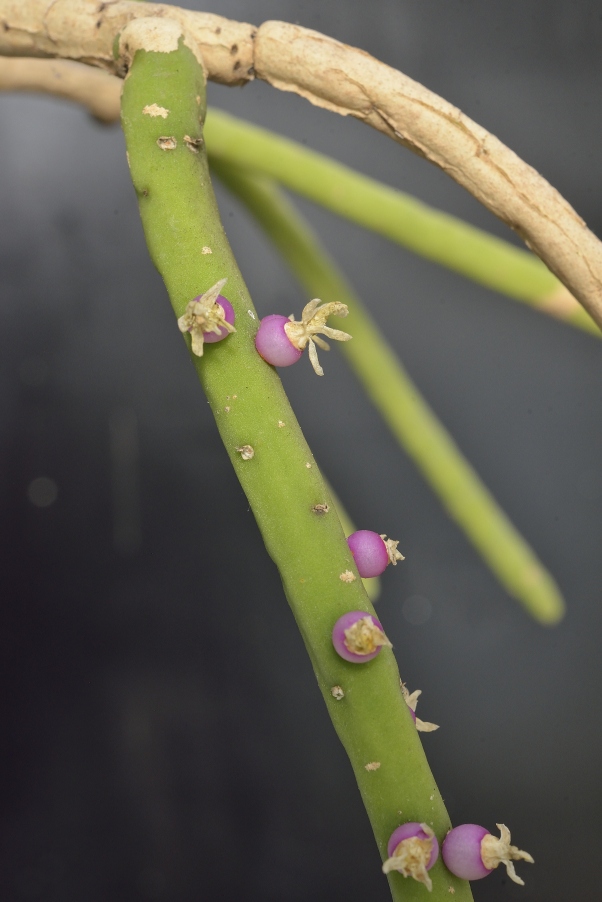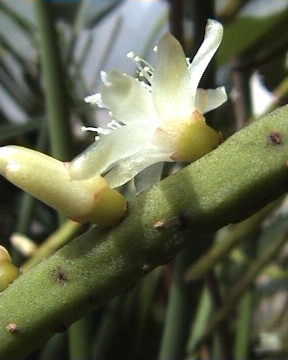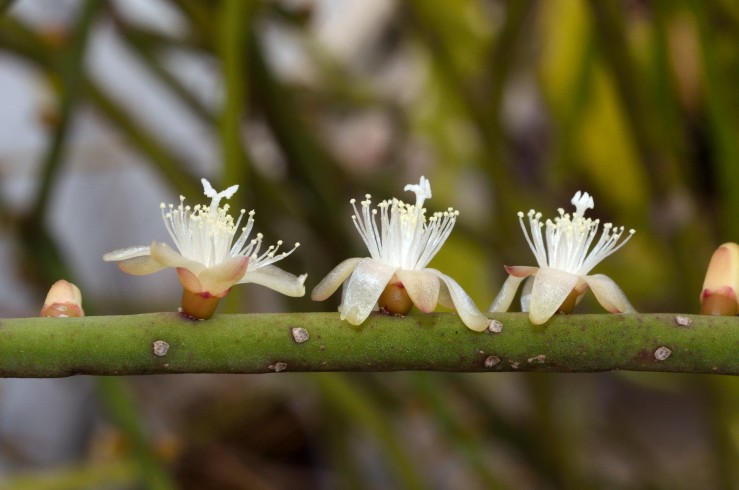

Rhipsalis grandiflora
Haw
◊◊ Supp. Plant. Succ. 83 (1819)
Cactus funalis Sprengel - Syst. Veg. 2:470 (1825)
Cactus cylindricus Vellozo - Fl. Flum. 207 non Lam 1783, non Ortega 1800 (1825)
Rhipsalis funalis (Sprengel)SD - in: DC Prodr. 3:476 (1828)
Rhipsalis calamiformis Pfeiff - Enum. Diagn. Cact. 135 (1837)
Rhipsalis funalis var minor Pfeiff - Enum. Diagn. Cact. 135 (1837)
Hariota funalis (SD)Lem - Cact. Gen. Nov. Spec. 74 (1839)
Rhipsalis cylindrica (Vell)Steudel (non Vpl) - Nom. Bot. ed. 2(2-5):448 (1841)
Hariota funalis (Sprengel)Cels ex Först - Handb. Cactkde. 457 (1846)
Hariota cylindrica (Vell)Küntze - Rev. Gen. Pl. 1:262 (1891)
Hariota grandiflora (Haw)Küntze - Rev. Gen. Plant. 1: 262 (1891)
Rhipsalis hadrosoma Lindb - Monatschr. Kakt. 6:96 (1896)
Rhipsalis robusta Lindb non Lem 1860 - Monatschr. Kakteenk. 6:53' (1896)
Rhipsalis fastigiata Hjelmq - Bot. Not. 356 (1941)
Lepismium grandiflorum (Haw)Backbg - Backeberg 2:691 (1959)

 - Hanging shrub. Main stem woody, up to 2 cm diameter. Segments branching dichotomously or in whorls, up to 1 m long, 1 cm diameter, cylindric, bright green, often yellowish or grey-green. Terminal stems 5-15 cm long. Areoles sunken, sometimes with a red ring, with few felt. Flower lateral, 1.5 cm long, up to 3 cm diameter. Ovary globose, green. Tepals whitish to yellow. Fruit white to reddish, naked, 6-7 mm diameter.
- Hanging shrub. Main stem woody, up to 2 cm diameter. Segments branching dichotomously or in whorls, up to 1 m long, 1 cm diameter, cylindric, bright green, often yellowish or grey-green. Terminal stems 5-15 cm long. Areoles sunken, sometimes with a red ring, with few felt. Flower lateral, 1.5 cm long, up to 3 cm diameter. Ovary globose, green. Tepals whitish to yellow. Fruit white to reddish, naked, 6-7 mm diameter.
- Brazil: Rio de Janeiro, São Paulo, Paraná, Santa Catarina. Epiphytic and epilythic on rocks near the coast and in coastal forests, up to 1200 m. Flowering period June to October.
Cact. 4:231, plate 21, 31
Backeberg 2:691
Backeberg 2:691, 2:662 (Rhipsalis hadrosoma)
Frst&Rmpl 886
Ritter 1:22, 283"
KuaS 13(5):68 (Rhipsalis hadrosoma)
Bradleya 13:65", 66, 67'
NCL 255"
Succulenta 97(1):44"
Rodriguésia 71 (2020)
◊◊ Supp. Plant. Succ. 83 (1819)
Cactus funalis Sprengel - Syst. Veg. 2:470 (1825)
Cactus cylindricus Vellozo - Fl. Flum. 207 non Lam 1783, non Ortega 1800 (1825)
Rhipsalis funalis (Sprengel)SD - in: DC Prodr. 3:476 (1828)
Rhipsalis calamiformis Pfeiff - Enum. Diagn. Cact. 135 (1837)
Rhipsalis funalis var minor Pfeiff - Enum. Diagn. Cact. 135 (1837)
Hariota funalis (SD)Lem - Cact. Gen. Nov. Spec. 74 (1839)
Rhipsalis cylindrica (Vell)Steudel (non Vpl) - Nom. Bot. ed. 2(2-5):448 (1841)
Hariota funalis (Sprengel)Cels ex Först - Handb. Cactkde. 457 (1846)
Hariota cylindrica (Vell)Küntze - Rev. Gen. Pl. 1:262 (1891)
Hariota grandiflora (Haw)Küntze - Rev. Gen. Plant. 1: 262 (1891)
Rhipsalis hadrosoma Lindb - Monatschr. Kakt. 6:96 (1896)
Rhipsalis robusta Lindb non Lem 1860 - Monatschr. Kakteenk. 6:53' (1896)
Rhipsalis fastigiata Hjelmq - Bot. Not. 356 (1941)
Lepismium grandiflorum (Haw)Backbg - Backeberg 2:691 (1959)

![]() - Hanging shrub. Main stem woody, up to 2 cm diameter. Segments branching dichotomously or in whorls, up to 1 m long, 1 cm diameter, cylindric, bright green, often yellowish or grey-green. Terminal stems 5-15 cm long. Areoles sunken, sometimes with a red ring, with few felt. Flower lateral, 1.5 cm long, up to 3 cm diameter. Ovary globose, green. Tepals whitish to yellow. Fruit white to reddish, naked, 6-7 mm diameter.
- Hanging shrub. Main stem woody, up to 2 cm diameter. Segments branching dichotomously or in whorls, up to 1 m long, 1 cm diameter, cylindric, bright green, often yellowish or grey-green. Terminal stems 5-15 cm long. Areoles sunken, sometimes with a red ring, with few felt. Flower lateral, 1.5 cm long, up to 3 cm diameter. Ovary globose, green. Tepals whitish to yellow. Fruit white to reddish, naked, 6-7 mm diameter.
- Brazil: Rio de Janeiro, São Paulo, Paraná, Santa Catarina. Epiphytic and epilythic on rocks near the coast and in coastal forests, up to 1200 m. Flowering period June to October.
Cact. 4:231, plate 21, 31
Backeberg 2:691
Backeberg 2:691, 2:662 (Rhipsalis hadrosoma)
Frst&Rmpl 886
Ritter 1:22, 283"
KuaS 13(5):68 (Rhipsalis hadrosoma)
Bradleya 13:65", 66, 67'
NCL 255"
Succulenta 97(1):44"
Rodriguésia 71 (2020)